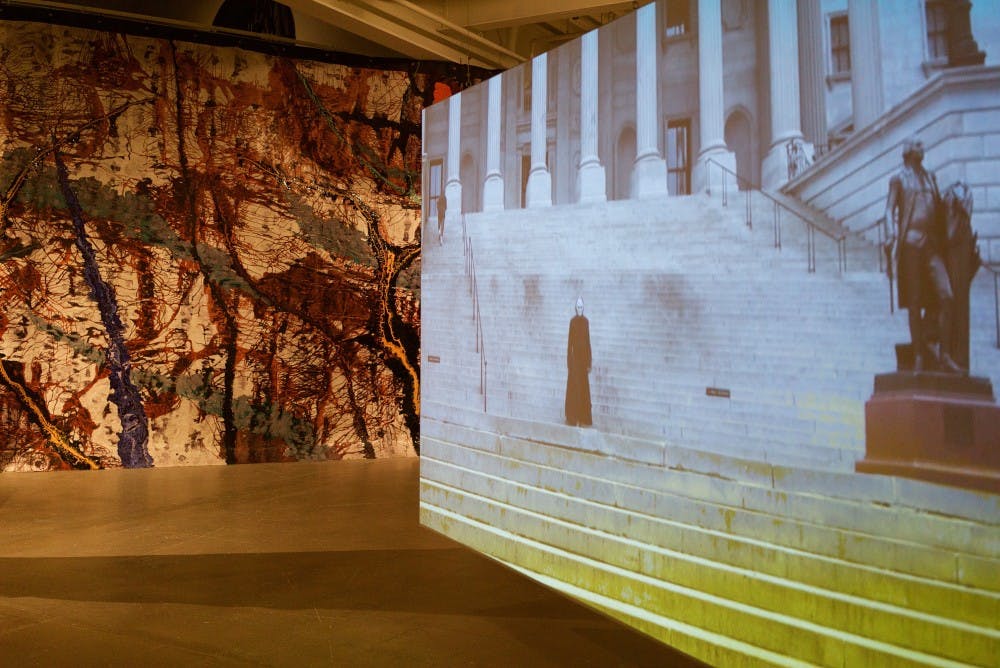The first thing you see as you enter the ground floor gallery of the Institute of Contemporary Art is a black tarp mounted on a white wall. Welcome to Rodney McMillian’s “The Black Show.”
The hole in the middle of the tarp is reminiscent of a fresh wound, filled with shiny black paint. Cracks emanate from it, implying that it will expand, swallowing the tarp and perhaps eventually the whole room.
Turn around, and three– dimensional black lungs bulge out towards you from a black frame. One is partially deflated.
The gallery is full of art of different mediums, all with only one obvious thing in common: the color black.
A television screen, suspended in the air, shows a room completely devoid of light except for that shining on a mask and pair of hands. The person wearing the mask seems to be threatening to advance toward the viewer, a terrifying premonition that, in the five minutes I stood there, never came to fruition. Another television screen shows black people dancing. A curtain cuts into the space, decorated with what looks like something Jackson Pollack might paint if asked to depict a forest. The most prominent color on it is black. This curtain creates a new space.
Behind the curtain, there is a speaker, bench and image projected on the wall. It shows an amateur video of a walk towards a run–down house. The person behind the camera breathes loudly, stumbling around to the point where it makes me kind of nauseated. Eventually, he makes his way through a dirty, unlivable house and places the camera on a steady surface (to my great relief).
A black man emerges, sits down on a chair and commences reading aloud from a big, dusty book of Winnie the Pooh. He seems to think that there is an audience of children on the floor behind the lens of the camera—he looks downwards and even pauses to show the pictures—but there is only me, the viewer, sitting on a bench in the ICA. The story is about Eeyore, the gloomy donkey, losing his tail, and Winnie the Pooh, the silly old bear, finding it. The story is nonsensical and profoundly non–nonsensical all at once. Pooh goes to visit wise old Owl, based on the logic that, “If anyone knows anything about anything, it's Owl who knows something about something, or my name's not Winnie the Pooh. Which it is. So there you are.” He arrives and rings the bell with the bell rope, and then asks Owl what he ought to do to find Eeyore’s tail. Owl suggests they “issue a reward,” which he has to say a few times as Pooh claims that Owl “sneezed just as you were going to tell me.” After a long argument about whether or not the word “issue” is a sneeze, Owl shows Pooh his brand new bell rope—the same one that Pooh rang in order to enter the house. It reminds Pooh of something, but he can’t think what. Then he remembers that it belongs to his friend Eeyore and that it must be returned because he is fond of it.
“Fond of it?” Owl asks.
“Attached to it,” says Pooh, sadly.
Given the title of this exhibit and the current political climate within the art community, I was waiting for a blatant political message to be shoved down my throat—but it never came. Instead, I interpreted from it a juxtaposition. The first two pieces—the black hole in the tarp and the black lungs—seem to imply, quite obviously, human mortality and insignificance. The messy and childlike streaks and blots that cover the curtain imply that chaos and randomness can go hand– in–hand with such insignificance. These are all big and pretentious ideas, the kind that every art reporter hopes to deduce in an exhibit they’re reviewing. Yet the projection the curtain houses depicts a reading from a book famously enjoyed both by children for its silliness and by adults for its acute wit. It evokes nostalgia in the viewer, which is perhaps the polar opposite to the existential crisis evoked by the pieces on the outside of the curtain.
And so I left having had an experience representative of the human experience. If this was the goal, then I would say the exhibit was a success. Though I have to say, it did seem rather pointless.

